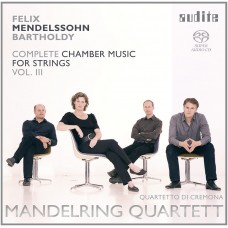您的購物車沒有添加專輯!
搜尋
孟德爾頌:弦樂室內樂全集第三集 Mendelssohn: Complete Chamber Music for Strings 3
|
Felix Mendelssohn did not write his six mature string quartets continually, but instead at particular pivotal points in his life and compositional career. In his youth, studying Bach and Beethoven proved to be fruitful, and later in life he was inspired by the exceptional violinist Ferdinand David to write his three Quartets Op. 44 between 1837 and 1839 (represented on this SACD by the final work in E flat major). They document the mature, formally assured Mendelssohn who sums up his instrumental writing: brilliantly composed (particularly for David’s violin), full of colour and formal attractions, romantic in their conduct. After completing his Quartet Op. 80 (contained in the second volume of the complete recording), Mendelssohn had not much time left to revisit and renew the string quartet. Two single surviving movements – a tenderly transfigured, but also irascible, Andante with five variations and a whispering Scherzo – were integrated into Op. 81 after Mendelssohn’s death. To Mendelssohn admirers, this Scherzo is faintly reminiscent of the Scherzo in the Octet Op. 20 with which the sixteen-year-old Felix, in a coup de main, created a new genre: “symphonic” chamber music where all “pianos and fortes need to be very precise and clearly separated and more distinctly emphasised than it is normally the case with pieces of this genre.” The jubilant opening of the octet, the romance-like Andante, the elastic, elf-like Scherzo and the rapid fugal finale – every movement is proof of the resourcefulness and the youthful genius of this “lovely episode in German music”, as Friedrich Nietzsche once referred to the composer Mendelssohn. |
編號 |
曲目 |
長度 |
作詞 |
作曲 |
演奏 |
樂團 |
演唱 |
指揮 |
試聽 |
|---|


